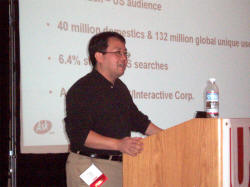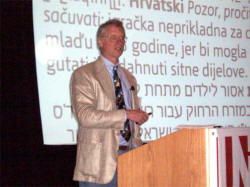|
Keynotes Presentations
Going Global with a Search Engine
Tuoc Luong, Executive
Vice President,
Engineering & Technology,
Ask Jeeves, Inc.
|
 |
Taking a web service global is best done from the beginning.
However, often is the case that software service is designed and
implemented for the United States first then re-designed later
for other languages and markets worldwide. This is the case with
the Ask Jeeves search service. This talk will touch on all
issues (both technical and non-technical) dealing with such a
re-design and move globally. Technical issues from language
identification, segmentation to geographical latency.
Non-technical issues from team dynamics, process in transition
to business decisions. The talk will give the audience a good
flavor of the issues involved in moving a highly scaleable
search engine internationally.
Read Keynote. |
|
|
UNICODE as a "Unifying Force" in Language Education
Colonel Daniel L. Scott, Assistant Commandant,
Defense Language Institute Foreign Language Center
|
 |
In the aftermath of 9/11 and the subsequent Global War on
Terrorism, a new family of languages has taken center stage. No
longer are languages from the Cold War era, Russian, Czech, or
German filling the corridors of the Pentagon. No longer are
mainstays of the academic world – Spanish, French and Italian –
garnering much attention. In this modern world conflict, ironically,
it’s often the ancient languages that are emerging and important --
languages, which, until quite recently, have not been the recipients
of much attention. As a nation, we need to quickly educate and train
large numbers of linguists and cultural experts, and we need to use
our technology to help us do that. |
|
Unfortunately, most of these ancient languages are not ready for
prime time in terms of computer support. Many
languages are only available in one font face that may or may not
render the characters in a legible or correct form. Screens often
show a mishmash of partially rendered characters interspersed with
the telltale “squares of death.“ The Defense Language Institute Foreign Language Center mission is
to train a new generation of linguists in these languages. We don’t
have the luxury of time to do all this work in the classroom with
traditional textbooks—we need to reach our students using the new
technologies of the web and gaming communities. The DLIFLC has
created an abundance of emerging language materials ranging from
printed Language Survival Guides to fully interactive, web-based
language training delivered on CDs and across the Internet.
Regardless of the medium of delivery, the DLI seeks solutions that
will allow seamless portability from one operating system or
application to another. This is absolutely crucial in meeting the
nation’s growing demands for language materials. By establishing and
strictly adhering to internal policies regarding the use of UNICODE
fonts, DLI can export critical materials throughout the country with
total confidence that they function as desired.
More importantly, a successful technical convention such as
UNICODE brings about change that is non-technical. UNICODE will help
us transform language training by streamlining curriculum,
implementing web-based testing, conducting on-line classes, and
fielding self-paced study and reference materials for linguists at
all proficiency levels and anywhere in the world. Linguists can use
these references from their offices, their homes, and from their
palm pilot at a checkpoint. In this sense, UNICODE becomes a
“unifying force“ for language education and support. We support and
applaud the efforts of the UNICODE community to lead the way.
Read Keynote. |
The Effect of Unicode on Type Design
Charles Bigelow, Vice President, Bigelow & Holmes Inc.
|
|
|
|
 |
The widespread adoption of Unicode has affected type design in
ways that were neither anticipated nor intended, but which may
become even more significant in the future. The main factor is the
creation of large fonts (“large“ in the sense of many characters)
which incorporate characters for several orthographies, scripts, and
symbols. A second factor is the structure of the Unicode Standard,
organized by named blocks of orthographies, scripts, and symbols. A
third factor is conflict between Unicode's definitional distinction
of glyphs from characters, and the naive user's “common sense“ view
that the glyphs depicted in the Unicode manual are in fact the
characters. |
|
Finally, there are legibility factors, user-interface issues, and
security problems that arise when different characters are
represented by glyphs, or combinations of glyphs, that appear
similar or identical in some circumstances, especially on display screens at small sizes
and low resolutions. This talk will be illustrated by examples of
glyphs and fonts from a variety of typefaces, ranging from Herman
Zapf's Euler fonts for mathematics, to Arial Unicode and Lucida
Grande and other “global“ fonts, as they are sometimes termed, as
well as scripts from Latin to Arabic to Kanji. The discussion will
occasionally use terms and notions borrowed from linguistics - such
such as analogy, phonemics, graphemics, grapholects, etc. - to explain and analyze
the various factors. |
|

